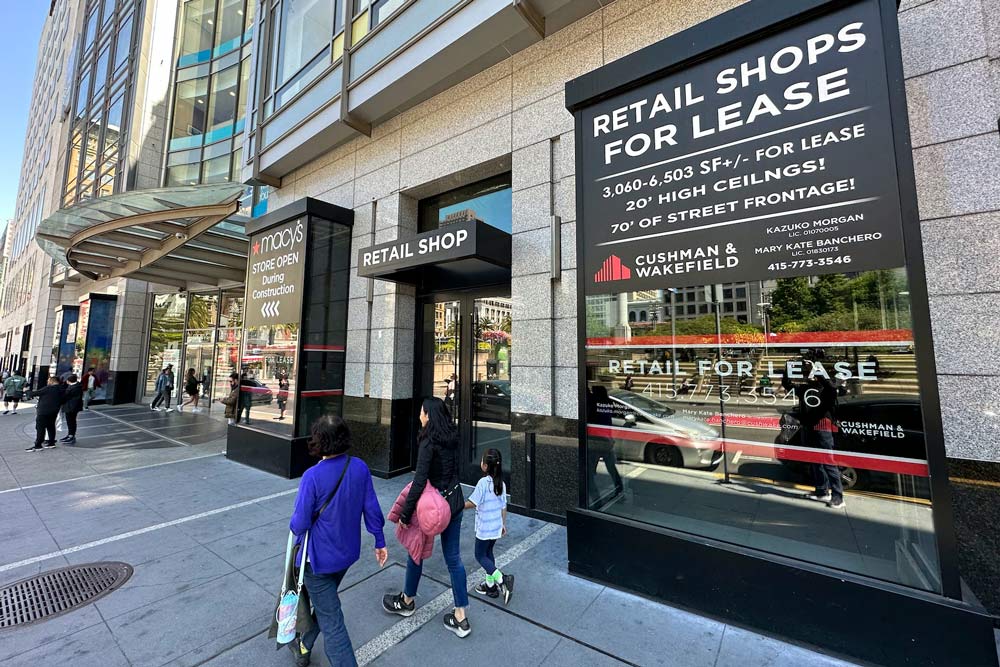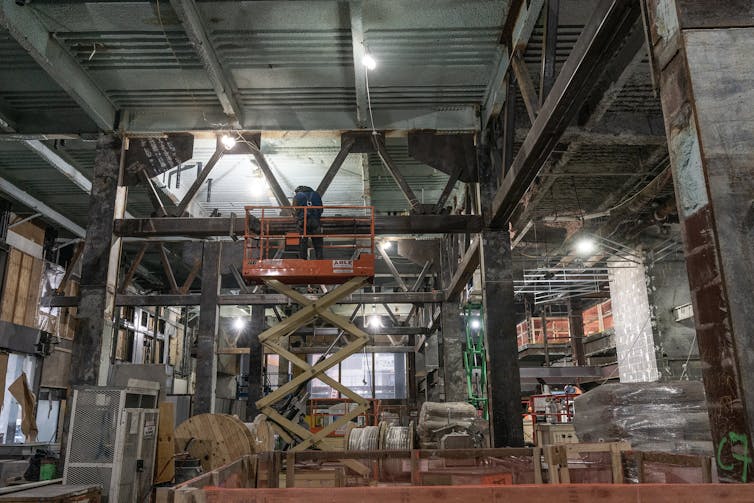
By John Rennie Short
The hollowing out of U.S. cities’ office and commercial cores is a national trend with serious consequences for millions of Americans. As more people have stayed home following the COVID-19 pandemic, foot traffic has fallen. Major retail chains are closing stores, and even prestigious properties are having a hard time retaining tenants.
The shuttering of a Whole Foods market after only a year in downtown San Francisco in May 2023 received widespread coverage. Even more telling was the high-end department store Nordstrom’s decision to close its flagship store there in August after a 35-year run.
In New York City, office vacancy rates have risen by over 70% since 2019. Chicago’s Magnificent Mile, a stretch of high-end shops and restaurants, had a 26% vacancy rate in spring 2023.
A recent study from the University of Toronto found that across North America, downtowns are recovering from the pandemic more slowly than other urban areas and that “older, denser downtowns reliant on professional or tech workers and located within large metros” are struggling the hardest.
Over more than 50 years of researching urban policy, I have watched U.S. cities go through many booms and busts. Now, however, I see a more fundamental shift taking place. In my view, traditional downtowns are dead, dying or on life support across the U.S. and elsewhere. Local governments and urban residents urgently need to consider what the post-pandemic city will look like.
Decades of overbuilding
U.S. downtowns were in trouble before the COVID-19 pandemic. Today’s overhang of excess commercial space was years in the making.
Urban property markets are speculative enterprises. When the economy is booming, individual developers decide to build more – and the collective result of these rational individual decisions is excess buildings.
In the 1980s, the Reagan administration allowed a quicker depreciation of commercial real estate that effectively lowered tax rates for developers. With financial globalization, foreign money flowed into the U.S. property sector, especially to very big development projects that could absorb large pools of liquid capital looking for relatively safe long-term investments.
Years of low interest rates meant cheap money for developers to finance their projects. City governments were eager to greenlight projects that would generate tax revenues. In many downtowns, office space now takes up between 70% and 80% of all real estate.

Lev Radin/Pacific Press/LightRocket via Getty Images
The pandemic push
COVID-19 finally burst this 40-year bubble. During pandemic lockdowns, many people worked from home and became comfortable with virtual meetings. Telecommuting grew as conventional commuting declined. Workers with the resources and job flexibility moved from cities to so-called “zoom towns” where housing was more affordable and parks and outdoor activities were close at hand.
Now, many employers want their staffs to return to the office. However, workers are pushing back, especially against spending full five-day weeks in the office. New technologies have made it easier to work from home, and a tight labor market has strengthened employees’ bargaining power.
There are significant knock-on effects. A range of businesses, including restaurants, retail stores and services, rely on downtown office workers. At least 17% of all leisure and hospitality sector jobs are in the downtowns of the 100 largest U.S. cities.
In San Francisco, for example, a typical office worker used to spend $168 near their office per week. Now, with nearly 150,000 fewer office workers commuting downtown, about 33,000 people in the service and retail sectors have lost their jobs.
Terminal decline?
Today, many cities are confronting the prospect of an urban doom loop, with a massive oversupply of office and retail space, fewer commuters and a looming urban fiscal crisis. Washington, D.C., is an illustration.
In December 2022, the city had approximately 27,000 fewer jobs than in February 2020, and it faced a growing financial shortfall from declining property taxes due to downtown business closures and fewer property purchases. The District of Columbia government projects that city revenues will decline by US$81 million in fiscal year 2024, $183 million in 2025 and $200 million in 2026. Washington’s Metropolitan Transit Authority faces a $750 million shortfall because of a sharp decline in ridership.
In the Communist Manifesto, Karl Marx and Friedrich Engels famously wrote that under the pressures of dynamic capitalism, “all that is solid melts into air.” They could have been describing the ever-changing built form of the United States, with people and money flowing to Main Street stores through the 1960s, then to suburban malls in the 1970s and 80s, then abandoning malls for revived downtowns and online shopping. Now, traditional downtowns may be in similar terminal decline.
Repurposing office space
What can cities do with their surplus office spaces? In some cities, such as Columbus, Ohio, investors are purchasing deeply discounted buildings, demolishing them and finding more profitable uses for the land, such as residential and mixed-use buildings. Other options include converting commercial space into residences or more specialized applications such as biotech labs.
But conversion is no panacea. There are many regulatory hurdles, although cities are changing zoning laws to make the process easier. Many office buildings have large internal floor spaces that makes it expensive to divide them into individual residential units that all receive outdoor light. And glass-sheathed buildings with windows that don’t open are prone to overheating.
Another approach is making downtowns more alluring, through steps such as waiving fees for food trucks and small businesses, offering free parking at night and on weekends and promoting events and eateries. The city of Columbus gives out lunch coupons for downtown restaurants.
Worcester, Massachusetts, offers financial aid for small businesses that move into vacant storefronts. San Francisco is considering a proposal to convert its downtown Westfield Centre Mall, formerly home to Nordstrom and other retailers, into a soccer stadium.
In my view, the growth of commercial office complexes that has long been promoted by investors, developers and federal and city governments has probably come to an end. The nation no longer needs so much office space. It will require more community involvement to find out what people want instead. Some communities may focus on housing, while others opt for more recreational opportunities or green spaces.
The downtown filled with acres of banal office blocks, with accompanying ground-level retail stores and shopping malls, is a relic of the 20th century. It’s daunting but exciting to envision what will take its place.
![]()
John Rennie Short is Professor Emeritus of Public Policy at the University of Maryland, Baltimore County.




























Pogo says
@FWIW — green acres…
https://www.google.com/search?q=Vertical+farming
Dennis C Rathsam says
When theres no law & order, no bail, what would you expect! Democrat cities are out of control, they are led by fools. N.Y, San Francisco, Chicago, just to name a few. Violence is running wild, no one cares no one stops it, it continues to escalate. When Guilianni was mayor NYC was safe, very little crime, all hours of the day. He cleaned up the mess the democrats left. Now we have democrats running the city and all hell broke loose again. Big cities can be saved, just not by democrats!
feddy says
Downtowns are dying, too dangerous. Funny the photo is taken in San Francisco and they found a great photo to use to push this article but everyone knows why San fran downtown area has dried up, crime, homeless and open drug use.
Dave says
Downtowns are dying, what about all the outlying strip shopping centers that are half empty as rent is outrageous. So what do developers do, they build more of them and the cities approve them. I see a trend, once a anchor store closes or moves, the rest of the shopping plaza is doomed. Case in point look no further than the Daytona Beach Volusia Mall. A housing developer is looking at housing units there. A local resident, “I think it makes great sense because you got dead malls all over the place and the malls already have used up the space and you don’t cut down any more trees,”
feddy says
The malls are dying because of online shopping, why go to the mall when I can get it delivered, that’s the mindset of the younger generations. I used to like going to the mall, you had everything you were looking for within a large building. The outlet malls took over, but their prices were really not that big of a discount.
Laurel says
It seems to me that planners should be talking with the younger folk about what they want as a community. What comes to my mind first is Celebration, Florida. The concept starts out right, with houses that have roads in the back, and a very large green space for play, walking and activities in the middle of the house rows. However, Celebration has HOA bylaws that are thicker than a New York City telephone book (when they still had them). I don’t think they incorporated the low, medium and high income housing, but I’m not sure.
I believe that all ages would love to have a community feeling, meet in the middle, walk-able, bike-able, close knit area. Since many business workers want to work from home, shopping, grocery, businesses offices and schools should be within easy commute, again, walk-able and bike-able or within a reasonable driving distance. Amazon, Walmart, Wayfair, and the like, deliver to your door. These far away strip malls no longer appeal.
City Place, in West Palm Beach, is another consideration. City Place is a fun place to visit, with shops, restaurants and entertainment on the ground floor, more shops and movie theater on the second floor, and apartments on the third floor. There is a very large courtyard with a Bellagio water feature, band-shell, performers and street vendors. Since it is right downtown, it is easy to get around to many more shops, activities, theaters and museums. Now again, I do not know about mixed income. That should be incorporated in any new planning.
This willy nilly growth because of “property rights” needs to stop. It is not taking into consideration what quality of life we are left with.
MITCH says
Look to Europe, their cities are not dying. Tourist are still flooding to European cities like Prague, London, Paris, etc – they are thriving. What has died are those with a vision to build cities like the ones still alive in Europe. You can not build thriving cities flooding your township properties with apartments. Visions that reject developers destruction of every square footage of property. Visions for a planned thriving self contained city community ; something todays developers have absolutely no concept how to make it work. What works so far; get as much cash as quick as possible and leave; don’t ask developers to build and be part of making this a self contained city community. City planners are not looking to develop a self containing traditional cities, just look what has already been approved; does it look like any traditional city you know of? Of course, no!
Bill C says
“An overwhelming 95 percent of properties in Paris are apartments, rather than houses, and a large number of them look very much alike.”
https://francetoday.com/learn/cityscapes_real_estate_in_french_cities/#:~:text=An%20overwhelming%2095%20percent%20of,them%20look%20very%20much%20alike.
endless dark money says
The world that made cities possible is quickly dying. 70% of all wildlife has died in the past 50 years due to our “lifestyles” . There are more hungry people today than at anytime in human history. This type of industrial consumerism will stop either by choice or extinction, they chose extinction, sorry kids.